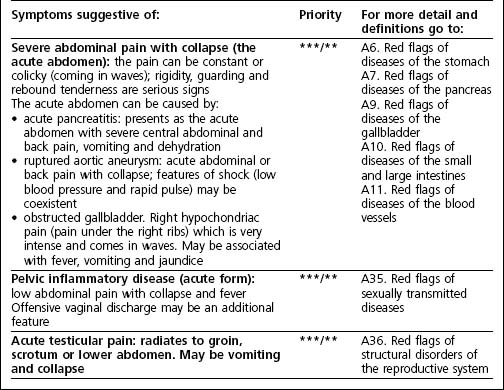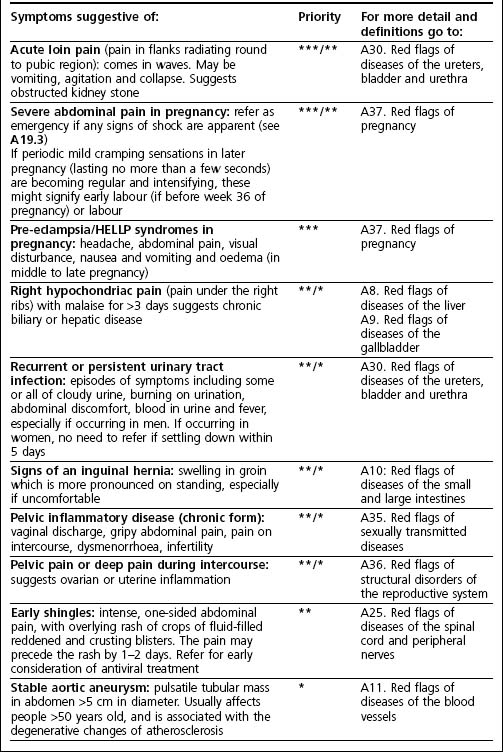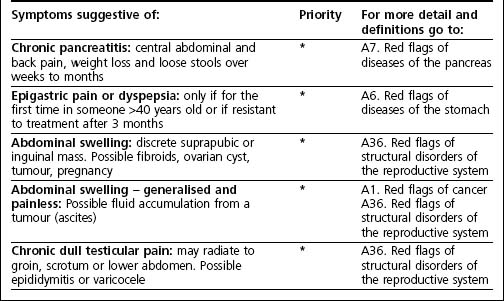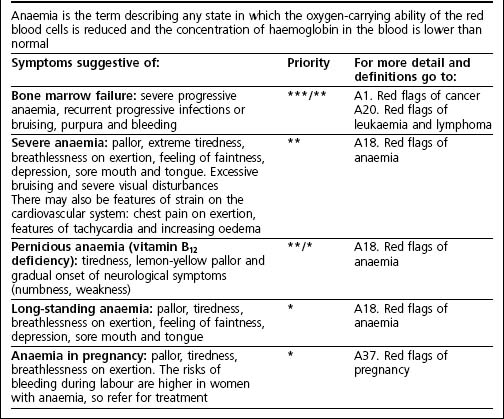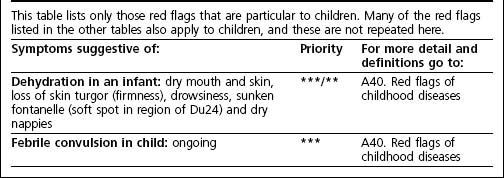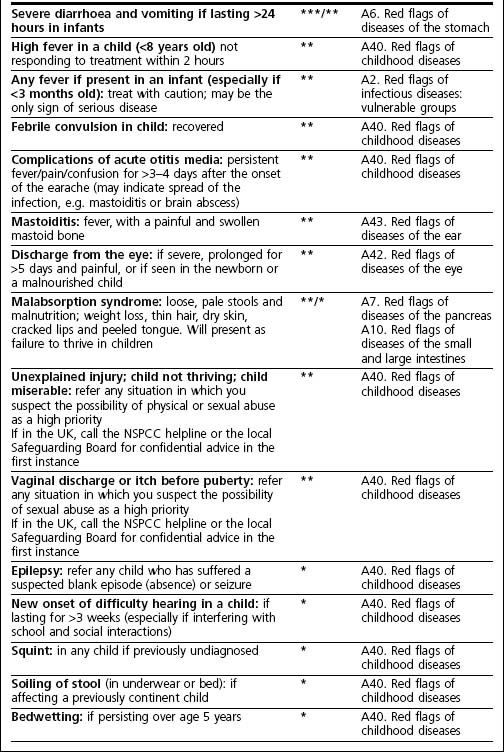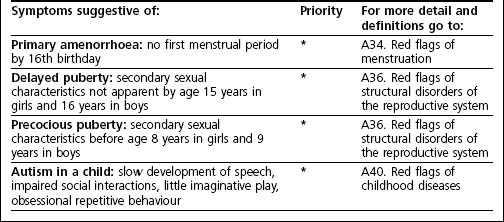Chapter 3 B tables
Red flags ordered by symptom keyword
Introduction
These lists are designed for quick access and summarise information in a very brief way. The reader is in all cases given a reference to lead them to consult the explanations found in the A tables in Chapter 2 for more detailed explanations and definitions of medical terms.
The order of the B tables can be found in the contents pages of this text.
TABLE B3 Red flags of anxiety or agitation
| Symptoms suggestive of: | Priority | For more detail and definitions go to: |
|---|---|---|
| Hypoglycaemia (due to effects of insulin or antidiabetic medication in excess of bodily requirements): agitation, sweating, dilated pupils, confusion and coma | *** | A32. Red flags of diabetes mellitus |
| Hallucinations, delusions or other evidence of thought disorder together with evidence of deteriorating self-care and personality change. All features of a psychosis such as schizophrenia. Suicide risk is high Refer urgently if behaviour is posing a risk to the patient or others | ***/** | A44. Red flags of mental health disorders |
| Mania: increasing agitation, grandiosity, pressure of speech and sleeplessness with delusional thinking. All features of bipolar disorder, a form of psychosis, which carries a high risk of behaviour that can be both socially and physically damaging to the patient. Suicide risk is high Refer urgently if behaviour is posing a risk to the patient or others | ***/** | A44. Red flags of mental health disorders |
| Post-natal psychosis: delusional or paranoid ideas and hallucinations are key features. This condition is associated with a high risk of suicide or harm to the baby Refer urgently if behaviour is posing a risk to the patient or others | ***/** | A38. Red flags of the puerperium |
| Organic mental health disorder (i.e. due to underlying gross physical abnormality): confusion, agitation, deterioration in intellectual skills, loss of ability to care for self. (Possible organic brain disorder such as drug intoxication, brain damage or dementia) | ***/** | A44. Red flags of mental health disorders |
| Hyperthyroidism: irritability, anxiety, sleeplessness, increased appetite, loose stools, weight loss, scanty periods and heat intolerance. Signs: sweaty skin, tremor of the hands, staring eyes and rapid pulse | **/* | A31. Red flags of diseases of the thyroid gland |
| Severe depression/obsessive–compulsive disorder or anxiety: if not responding to treatment and seriously affecting quality of life | * | A44. Red flags of mental health disorders |
| Severe disturbance of body image: resulting in features of progressive anorexia nervosa or bulimia nervosa (e.g. progressive weight loss, secondary amenorrhoea, repeated compulsion to bring about vomiting) | * | A44. Red flags of mental health disorders |
TABLE B4 Red flags of bleeding or blood loss
| Symptoms suggestive of: | Priority | For more detail and definitions go to: |
|---|---|---|
| Severe blood loss leading to shock: if the following symptoms and signs have been present for more than a few minutes (i.e. not just simple faint) or are worsening: dizziness, fainting and confusion. Rapid pulse of >100 beats/minute. Blood pressure <90/50 mmHg. Cold and clammy extremities | *** | A19. Red flags of haemorrhage and shock |
| Bone marrow failure: symptoms of progressive anaemia, recurrent progressive infections, progressive bruising, purpura and bleeding | ***/** | A20. Red flags of leukaemia and lymphoma |
| Vomiting of fresh blood or altered blood (haematemesis): if blood is altered, it looks like dark gravel or coffee grounds in the vomit | ***/** | A6. Red flags of diseases of the stomach A8. Red flags of diseases of the liver |
| Altered blood in stools (melaena): stools look like black tar. Suggests large amount of bleeding from stomach | ***/** | A6. Red flags of diseases of the stomach |
| Any episode of vaginal bleeding in pregnancy: refer as an emergency if any signs of shock are apparent (low blood pressure, fainting, rapid pulse), as internal bleeding may not become immediately apparent. Otherwise refer as a high priority for investigation of cause | ***/** | A37. Red flags of pregnancy |
| Post-partum haemorrhage: if bleeding after childbirth is any more than a blood-stained discharge A profuse bleed of >500 mL or the symptoms of shock (low blood pressure, fainting, rapid pulse rate) constitutes an emergency | ***/** | A38. Red flags of the puerperium |
| Continuing blood loss: any situation in which significant bleeding is continuing for more than a few minutes without any signs of abating (e.g. nosebleed), except within the context of menstruation | ***/** | A19. Red flags of haemorrhage and shock |
| Unexplained bleeding: either from the surface of the skin or emerging from an internal organ, such as the bowel, bladder or uterus | ** | A1. Red flags of cancer |
| Infectious bloody diarrhoea or food poisoning: any episode of diarrhoea and vomiting in which food is suspected as the origin, or in which blood appears in the stools. These are notifiable diseases | ** | A10. Red flags of diseases of the small and large intestines |
| Blood mixed in with stools: fresh blood mixed in with the stools suggests colonic or rectal origin Blood that drips after passage of stools is anal in origin and is usually benign (no need to refer) | ** | A10. Red flags of diseases of the small and large intestines |
| Coughing up of blood (haemoptysis): (if on only a single occasion, only amounts more than a teaspoon in volume are significant) | ** | A17. Red flags of lower respiratory disease |
| Tuberculosis infection: chronic productive cough, weight loss, night sweats, blood in sputum for >2 weeks | ** | A17. Red flags of lower respiratory disease |
| Blood in the urine or sperm: refer all cases in men. Refer in women except in the case of acute urinary infection, in which case it is usually benign | **/* | A29. Red flags of diseases of the kidneys A30. Red flags of diseases of the ureters, bladder and urethra |
TABLE B5 Red flags of disorders of the breast
| Symptoms suggestive of: | Priority | For more detail and definitions go to: |
|---|---|---|
| Mastitis in pregnancy or puerperium: if not responding to treatment in 2 days or if features of an abscess (inflamed mass with severe malaise) present | **/* | A38. Red flags of the puerperium A39. Red flags of diseases of the breast |
| Inflamed breast tissue but not breastfeeding: it is rare to develop inflammation if not breastfeeding; may suggest underlying tumour | **/* | A39. Red flags of diseases of the breast |
| Insufficient breast milk: if the mother is considering stopping breastfeeding because of insufficient milk, refer to midwife for breastfeeding advice, as once a baby becomes reliant on formula milk it is often an irreversible decision | **/* | A38. Red flags of the puerperium |
| Lump in the breast: always refer for investigation. One in 10 breast lumps is cancerous | * | A39. Red flags of diseases of the breast |
| Eczema of nipple region: may be due to Bowen’s disease (form of breast cancer) | * | A39. Red flags of diseases of the breast |
| Lactation but not breastfeeding: might suggest pituitary disorder | * | A39. Red flags of diseases of the breast |
| Hypopituitarism: inappropriate lactation, loss of libido, infertility, menstrual disturbances, tiredness, low blood pressure | * | A33. Red flags of other endocrine diseases |
TABLE B6 Red flags of breathlessness or difficulty in breathing (see also B12: red flags of cough)
| Symptoms suggestive of: | Priority | For more detail and definitions go to: |
|---|---|---|
| Severe asthma: at least two of the following – rapidly worsening breathlessness, >30 respirations/minute (or more if a child1), heart rate >110 beats/minute, reluctance to talk because of breathlessness, need to sit upright and still to assist breathing. Cyanosis is a very serious sign | *** | A17. Red flags of lower respiratory disease |
| Infection of the alveoli (pneumonia): cough, fever, malaise, >30 respirations/minute (or more if a child1), heart rate >110 beats/minute, reluctance to talk because of breathlessness, need to sit upright and still to assist breathing. Cyanosis is a very serious sign | ***/** | A17. Red flags of lower respiratory disease |
| Progression of respiratory infection to the lower respiratory tract: breathlessness with malaise suggests the involvement of the bronchi or lower air passages. Usually accompanied by cough and fever, but may be the only symptom of an infection in the elderly or immunocompromised | ***/** | A16. Red flags of upper respiratory disease |
| Pulmonary embolism: sudden onset of pleurisy (chest pain exacerbated by breathing in), with breathlessness, cyanosis, collapse and blood in sputum | *** | A17. Red flags of lower respiratory disease |
| Sudden lung collapse (pneumothorax): onset of severe breathlessness, may be some pleurisy (chest pain exacerbated by breathing in) and collapse if very severe | *** | A17. Red flags of lower respiratory disease |
| Stridor (harsh noisy breathing heard on both the inbreath and outbreath): suggests obstruction to upper airway. Patient will want to sit upright and be still. Don’t ask to examine the tongue | ***/** | A16. Red flags of upper respiratory disease |
| Any new onset of difficulty breathing in a young child (<8 years old): possible asthma (suggested by the presence of cough), chest infection, foreign body in airway, allergic reaction. All need assessing, but some may require urgent treatment | ***/**/* | A16. Red flags of upper respiratory disease |
| Unstable angina or heart attack: sustained intense chest pain associated with fear or dread. Palpitations and breathlessness may be present. The patient may vomit or develop a cold sweat. Beware: in the elderly can present as sudden onset of breathlessness, palpitations or confusion, but without pain | *** | A13. Red flags of angina and heart attack |
| Acute heart failure: sudden onset of disabling breathlessness and watery cough | *** | A14. Red flags of heart failure and arrhythmias |
| Any sudden or gradual onset of muscle weakness that might be affecting muscles of respiration: needs to be referred urgently, as condition may progress to respiratory failure | *** | A25. Red flags of diseases of the spinal cord and peripheral nerves |
| Severe chronic heart failure: marked swelling of ankles and lower legs, disabling breathlessness, cough and exhaustion. There may also be palpitations and chest pain on exertion | ** | A14. Red flags of heart failure and arrhythmias |
| Mild chronic heart failure: slight swelling of ankles, slight breathlessness on exertion and when lying flat, cough, but no palpitations or chest pain | * | A14. Red flags of heart failure and arrhythmias |
| Stable angina: central chest pain related to exertion, eating or the cold which improves with rest. Pain is heavy and gripping (rather than sharp or stabbing), and can radiate down neck and arms Beware: in the elderly can present as episodes of breathlessness/chest tightness, but without pain | **/* | A13. Red flags of angina and heart attack |
| Complicated pericarditis: sharp central chest pain that is worse on leaning forward and lying down. Fever. Associated palpitations and breathlessness are more serious features | ** | A15. Red flags of pericarditis |
| Pleurisy: localised chest pain which is associated with inspiration and expiration. Refer if associated with fever and breathlessness, as this is an indication of underlying pneumonia | ** | A17. Red flags of lower respiratory disease |
| Long-standing anaemia: pallor, tiredness, breathlessness on exertion, feeling of faintness, depression, sore mouth and tongue | **/* | A18. Red flags of anaemia |
| Unexplained persistent blockage of nostril on one side: in an adult this suggests possible nasopharyngeal carcinoma; refer for investigations if persisting for >3 weeks In a child this suggests obstruction by a foreign body; refer as a high priority | */** | A16. Red flags of upper respiratory disease A40. Red flags of childhood diseases |
The normal range for respiratory rate in children varies according to age.
The following rates indicate moderate to severe breathlessness:
1Categorisation of respiratory rate in children:
| newborn (0–3 months) | >60 breaths/minute |
| infant (3 months to 2 years) | >50 breaths/minute |
| young child (2–8 years) | >40 breaths/minute |
| older child to adult | >30 breaths/minute |
TABLE B7 Red flags of bruising and purpura1
| Symptoms suggestive of: | Priority | For more detail and definitions go to: |
|---|---|---|
| Bone marrow failure: severe progressive anaemia, recurrent progressive infections or bruising, purpura and bleeding | ***/** | A1. Red flags of cancer A20. Red flags of leukaemia and lymphoma |
| Severe headache with fever and with a bruising and non-blanching rash: suggests meningococcal meningitis | *** | A23. Red flags of headache |
| Bruising and non-blanching rash with severe malaise: suggests meningococcal septicaemia | *** | A11. Red flags of diseases of the blood vessels |
| Purpura or bruising rash (non-blanching): suggests a bleeding disorder or vasculitis | ***/** | A41. Red flags of diseases of the skin |
| Oedema, bruising and confusion in someone with known liver disease: suggests liver disease has progressed to a serious stage, and the patient is at risk of coma | ** | A8. Red flags of diseases of the liver |
| Severe anaemia: extreme tiredness and breathlessness on exertion, excessive bruising and severe visual disturbances. There may also be features of strain on the cardiovascular system: chest pain on exertion, tachycardia and increasing oedema | ** | A18. Red flags of anaemia |
1Purpura is pinpoint bruising that appears as a rash of small, red, non-blanching macules. It may result from low platelets or from inflammation of the blood vessels (vasculitis).
TABLE B8 Red flags of chest pain
| Symptoms suggestive of: | Priority | For more detail and definitions go to: |
|---|---|---|
| Unstable angina or heart attack: sustained intense chest pain associated with fear or dread. Palpitations and breathlessness may be present. The patient may vomit or develop a cold sweat Beware: in the elderly can present as sudden onset of breathlessness, palpitations or confusion, but without pain | *** | A13. Red flags of angina and heart attack |
| Pulmonary embolism: sudden onset of pleurisy (chest pain related to breathing in) with breathlessness, cyanosis, collapse and blood in sputum | *** | A17. Red flags of lower respiratory disease |
| Sudden lung collapse (pneumothorax): breathlessness; may be some pleurisy and collapse if very severe | *** | A17. Red flags of lower respiratory disease |
| Complicated pericarditis: sharp central chest pain that is worse on leaning forward and lying down. Fever. Associated palpitations and breathlessness are more serious features | ***/** | A15. Red flags of pericarditis |
| Dissecting aortic aneurysm: sudden onset, tearing chest pain with radiation to back. Features of shock may be present (faintness, low blood pressure, rapid pulse) | *** | A13. Red flags of angina and heart attack |
| Stable angina: central chest pain related to exertion, eating or the cold and which improves with rest. Pain is heavy and gripping (rather than sharp or stabbing), and can radiate down neck and arms Beware: in the elderly can present as episodes of breathlessness/chest tightness, but without pain | **/* | A13. Red flags of angina and heart attack |
| Uncomplicated pericarditis: sharp central chest pain which is worse on leaning forward and lying down. Fever should be slight and pulse rate no more than 100 beats/minute | ** | A15. Red flags of pericarditis |
| Pleurisy: localised chest pain that is associated with inspiration and expiration. Refer if associated with breathlessness, as this is an indication of associated pneumonia or pulmonary embolism | ** | A17. Red flags of lower respiratory disease |
| New onset of chronic cough or deep persistent chest pain in a smoker: this could be the first sign of bronchial carcinoma | **/* | A17. Red flags of lower respiratory disease |
| Early shingles: intense, one-sided pain, with overlying rash of crops of fluid-filled reddened and crusting blisters. The pain may precede the rash by 1–2 days. Refer for early consideration of antiviral treatment | ** | A25. Red flags of diseases of the spinal cord and peripheral nerves |
TABLE B10 Red flags of collapse and loss of consciousness (see also B11: red flags of confusion and clouding of consciousness)
| Symptoms suggestive of: | Priority | More detail |
|---|---|---|
| Cardiac arrest: collapse with no palpable pulse | *** | A14. Red flags of heart failure and arrhythmias |
| Loss of consciousness (continuing loss of neurological function): diverse causes include stroke, metabolic disease, brain infection, intoxication | *** | A22. Red flags of brain haemorrhage, stroke and brain tumour |
| Rapid increase in intracranial pressure (intracranial haemorrhage): headache followed by a rapid deterioration of consciousness leading to coma. Irregular breathing patterns and pinpoint pupils are a very serious sign May be spontaneous or may result from a head injury | *** | A21. Red flags of raised intracranial pressure A22. Red flags of brain haemorrhage, stroke and brain tumour |
| First ever epileptic seizure: generalised tonic–clonic seizure: convulsions, loss of consciousness, bitten tongue, emptying of bladder and/or bowels. This is an emergency if the fit does not settle down within 2 minutes. Refer as high priority if fit has settled down | *** | A24. Red flags of dementia, epilepsy and other disorders of the central nervous system |
| A severe headache that develops over the course of a few hours to days with fever, together with either vomiting or neck stiffness. The patient may become drowsy or unconscious. Suggests acute meningitis or encephalitis | *** | A23 Red flags of headache |
| Febrile convulsion in child: ongoing | *** | A3. Red flags of infectious diseases: fever, dehydration and confusion |
| Confusion/coma with dehydration (hyperglycaemia) | *** | A32. Red flags of diabetes mellitus |
| Hypoglycaemia (due to effects of insulin or antidiabetic medication in excess of bodily requirements): agitation, sweating, dilated pupils, confusion and coma | *** | A32. Red flags of diabetes mellitus |
| Pulmonary embolism: sudden onset of pleurisy (chest pain on breathing in) with breathlessness, cyanosis, collapse | *** | A17. Red flags of lower respiratory disease |
| Sudden lung collapse (pneumothorax): onset of severe breathlessness, may be some pleurisy (chest pain on breathing in) and collapse if very severe | *** | A17. Red flags of lower respiratory disease |
| General symptoms of shock: dizziness, fainting and confusion. Rapid pulse of >100 beats/minute. Blood pressure <90/60 mmHg. Cold and clammy extremities. Refer if these symptoms are worsening or sustained (more than a few seconds) | *** | A19. Red flags of haemorrhage and shock |
| Addison’s disease: increased pigmentation of skin, weight loss, muscle wasting, tiredness, loss of libido, low blood pressure, diarrhoea and vomiting, confusion, collapse with dehydration | ***/** | A33. Red flags of other endocrine diseases |
| Febrile convulsion in child: recovered | ** | A40. Red flags of childhood diseases |
| Unexplained falls or faints in elderly person: may be the result of an arrhythmia (cardiac syncope) | **/* | A14 Red flags of heart failure and arrhythmias |
| A temporary loss of neurological function (usually <2 hours long): recovery from loss of consciousness, loss of vision, unsteadiness, confusion, loss of memory, loss of sensation or limb weakness | ** | A22. Red flags of brain haemorrhage, stroke and brain tumour |
| Simple fainting: dizziness, temporary collapse (no more than a few seconds) and temporary confusion. Normal or slowed pulse rate. Blood pressure <90/60 mmHg. Cold and clammy extremities. Patient starts to recover in seconds to a minute. No need to refer | – | A19. Red flags of haemorrhage and shock |
TABLE B11 Red flags of confusion and clouding of consciousness (see also B10: red flags of collapse and loss of consciousness)
| Symptoms suggestive of: | Priority | For more detail and definitions go to: |
|---|---|---|
| General symptoms of shock: dizziness, fainting and confusion. Rapid pulse of >100 beats/minute. Blood pressure <90/60 mmHg. Cold and clammy extremities. Refer if these symptoms are worsening or sustained (more than a few seconds) | *** | A19. Red flags of haemorrhage and shock |
| Hypoglycaemia (due to effects of insulin or antidiabetic medication in excess of bodily requirements): agitation, sweating, dilated pupils, confusion and coma | *** | A32. Red flags of diabetes mellitus |
| Confusion/coma with dehydration (hyperglycaemia) | *** | A32. Red flags of diabetes mellitus |
| Unusual drowsiness in infants (especially if <3 months old): may signify underlying serious illness | ***/** | A2. Red flags of infectious diseases: vulnerable groups |
| Organic mental health disorder (a mental health condition due to an underlying gross physical cause): acute confusion, agitation, visual hallucinations, deterioration in intellectual skills, loss of ability to care for self. (These suggest organic brain disorder such as metabolic disease, drug intoxication, brain damage or dementia) | ***/** | A44. Red flags of mental health disorders |
| A persisting loss of neurological function: including loss of vision, unsteadiness, confusion, loss of memory, loss of sensation or muscle weakness (possible stroke or multiple sclerosis) | *** | A22. Red flags of brain haemorrhage, stroke and brain tumour A24. Red flags of dementia, epilepsy and other disorders of the central nervous system |
| Hallucinations, delusions or other evidence of thought disorder together with evidence of deteriorating self-care and personality change: all are features of a psychosis such as schizophrenia. Suicide risk is high | ***/** | A44. Red flags of mental health disorders |
| Mania: increasing agitation, grandiosity, pressure of speech and sleeplessness with delusional thinking: all are features of bipolar disorder, a form of psychosis that carries a high risk of behaviour that can be both socially and physically damaging to the patient. Suicide risk is high | ***/** | A44. Red flags of mental health disorders |
| Post-natal psychosis: delusional or paranoid ideas and hallucinations are key features. This condition is associated with a high risk of suicide or harm to the baby | ***/** | A38. Red flags of the puerperium |
| Acute confusion in an elderly person: can result from an underlying medical condition, such as stroke, heart attack, infection or pain | ***/** | A2. Red flags of infectious diseases: vulnerable groups |
| Confusion in older children and adults with fever | ** | A3. Red flags of infectious diseases: fever, dehydration and confusion |
| Slow increase in intracranial pressure: progressive headaches and vomiting over the timescale of a few weeks to months. The headaches are worse in the morning and the vomiting may be effortless. Blurring of vision and confusion may be additional symptoms | ** | A21. Red flags of raised intracranial pressure |
| Loss of neurological function which is progressive over the course of days to weeks: may include confusion. This is more suggestive of a brain tumour than a stroke | ** | A22. Red flags of brain haemorrhage, stroke and brain tumour |
| Pernicious anaemia: tiredness, lemon-yellow pallor and gradual onset of neurological symptoms (numbness, weakness, confusion) | **/* | A18. Red flags of anaemia |
| A temporary loss of neurological function (usually <2 hours long): recovery from loss of consciousness, loss of vision, unsteadiness, confusion, loss of memory, loss of sensation or limb weakness (possible transient ischaemic attack (TIA)) | **/* | A22. Red flags of brain haemorrhage, stroke and brain tumour A24. Red flags of dementia, epilepsy and other disorders of the central nervous system |
| Progressive decline in mental and social functioning: increasing difficulty in intellectual function, memory, concentration and use of language | * | A22. Red flags of brain haemorrhage, stroke and brain tumour A24. Red flags of dementia, epilepsy and other disorders of the central nervous system |
| First ever epileptic seizure (complex partial): generalised absence or complex partial seizures: defined periods of vagueness or loss of awareness, or mood or personality changes. Refer any child who has suffered a suspected blank episode (absence) or seizure | * | A24. Red flags of dementia, epilepsy and other disorders of the central nervous system |
| Simple fainting: dizziness, temporary collapse (no more than a few seconds) and temporary confusion. Normal or slowed pulse rate. Blood pressure <90/60 mmHg. Cold and clammy extremities. Patient starts to recover in seconds to a minute. No need to refer | – | A19. Red flags of haemorrhage and shock |
TABLE B12 Red flags of cough (see also B6: red flags of breathlessness and difficulty breathing)
| Symptoms suggestive of: | Priority | For more detail and definitions go to: |
|---|---|---|
| Acute heart failure: sudden onset of disabling breathlessness and watery cough | *** | A14. Red flags of heart failure and arrhythmias |
| Infection of the alveoli (pneumonia): cough, fever, malaise, >30 respirations/minute (or more if a child1), heart rate >110 beats/minute, reluctance to talk because of breathlessness, need to sit upright and be still to assist breathing. Cyanosis is a very serious sign | ***/** | A17. Red flags of lower respiratory disease |
| Progression of infection to the lower respiratory tract: breathlessness1 with malaise suggests the involvement of the bronchi or lower air passages. Usually accompanied by cough and fever, but may be the only symptom of an infection in the elderly or immunocompromised | ***/** | A16. Red flags of upper respiratory disease |
| Any new onset of difficulty breathing in a young child (<8 years old): possible asthma (suggested by coughing as well as difficulty breathing), chest infection, foreign body in airway, allergic reaction. All need assessing, but some may require urgent treatment | ***/**/* | A16. Red flags of upper respiratory disease |
| Progressive upper respiratory infection in susceptible people (e.g. the frail elderly, the immunocompromised and people with pre-existing disease of the bronchi and bronchioles): cough and fever, or new production of yellow–green phlegm, each persisting for >3 days | ** | A16. Red flags of upper respiratory disease A17. Red flags of lower respiratory disease |
| Tuberculosis infection: chronic productive cough, weight loss, night sweats, blood in sputum for >2 weeks | ** | A17. Red flags of lower respiratory disease |
| New onset of chronic cough or deep persistent chest pain in a smoker | **/* | A17. Red flags of lower respiratory disease |
| Severe chronic heart failure: marked swelling of ankles and lower legs, disabling breathlessness, cough and exhaustion. There may also be palpitations and chest pain on exertion | ** | A14. Red flags of heart failure and arrhythmias |
| Coughing up of blood (haemoptysis): (if on only a single occasion, only amounts more than a teaspoon in volume are significant) | ** | A17. Red flags of lower respiratory disease |
| Mild chronic heart failure: slight swelling of ankles, slight breathlessness on exertion and when lying flat, cough, but no palpitations or chest pain. Dry cough may be the only symptom in sedentary elderly people | * | A14. Red flags of heart failure and arrhythmias |
Categorisation of respiratory rate in children:
The normal range for respiratory rate in children varies according to age.
The following rates indicate moderate to severe breathlessness:
1Categorisation of respiratory rate in adults:
– Normal respiratory rate in an adult: 10–20 breaths/minute (one breath is one inhalation and exhalation).
– Moderate breathlessness in an adult: >30 breaths/minute.
Stay updated, free articles. Join our Telegram channel

Full access? Get Clinical Tree


